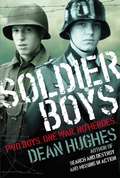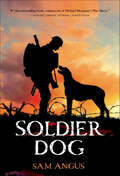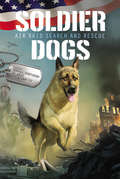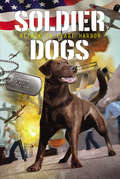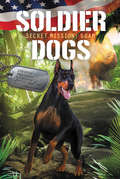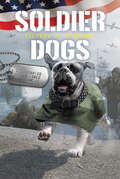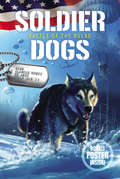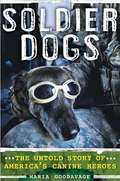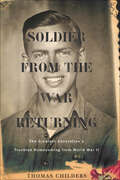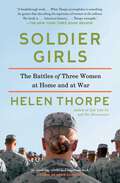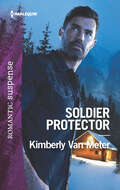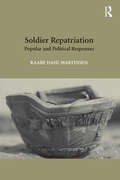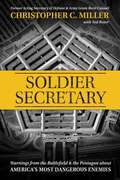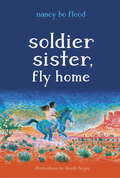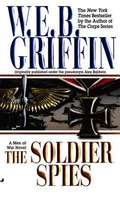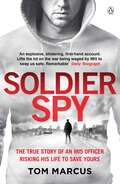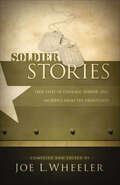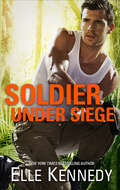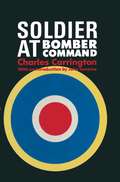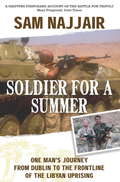- Table View
- List View
Soldier Boys
by Dean HughesSpencer Morgan And Dieter Hedrick, one American, one German, are both young and eager to get into action in the war. Dieter, a shining member of the Hitler Youth movement, has actually met the Führer himself and was praised for his hard work. Now he is determined to make it to the front lines, to push back the enemy and defend the honor of the Fatherland.Spencer, just sixteen, must convince his father to sign his induction papers. He is bent on becoming a paratrooper -- the toughest soldiers in the world. He will prove to his family and hometown friends that he is more than the little guy with crooked teeth. He?ll prove to his father that he can amount to something and keep his promises. Everyone will look at him differently when he returns home in his uniform, trousers tucked into his boots in the paratrooper style.Both boys get their wishes when they are tossed into intense conflict during the Battle of the Bulge. And both soon learn that war is about a lot more than proving oneself and one?s bravery. Dean Hughes offers young readers a wrenching look at parallel lives and how innocence must eventually be shed.
Soldier Dead: How We Recover, Identify, Bury, & Honor Our Military Fallen
by Michael SledgeThe first book to address the complicated issues surrounding what happens to members of the United States Armed Forces after they die. Why does recovering the remains of servicepeople matter? Soldier Dead examines this question and provides a thorough analysis of the processes of recovery, identification, return, burial, and remembrance of the dead. Sledge traces the ways in which the handling of our Soldier Dead has evolved over time and how these changes have reflected not only advances in technology and capabilities but also the shifting attitudes of the public, government, and military. He also considers the emotional stress experienced by those who handle the dead; the continuing efforts to retrieve bodies from Korea and elsewhere; and how unresolved issues regarding the treatment of enemy dead continue to affect U.S. foreign relations. Skillfully incorporating excerpts from interviews, personal correspondence and diaries, military records, and journalistic accounts—as well as never-before-published photographs and his own reflections—Michael Sledge presents a clear, concise, and compassionate story about what the dead mean to the living. Throughout Soldier Dead, the voices of the fallen are heard, as are those of family members and military personnel responsible for the dead before final disposition. At times disturbing and at other times encouraging, they are always powerful as they speak of danger, duty, courage, commitment, and care. &“A timely and detailed investigation into the moral conscience of American society which will be of interest to anyone concerned with the human costs of war. An important and passionate book which deserves a wide readership.&”—Chris Shilling, University of Portsmouth, UK
Soldier Dead: How We Recover, Identify, Bury, and Honor Our Military Fallen (Published By The Middle East Institute)
by Michael SledgeWhat happens to members of the United States Armed Forces after they die? Why do soldiers endanger their lives to recover the remains of their comrades? Why does the military spend enormous resources and risk further fatalities to recover the bodies of the fallen, even decades after the cessation of hostilities? Soldier Dead is the first book to fully address the complicated physical, social, religious, economic, and political issues concerning the remains of men and women who die while serving their country. In doing so, Michael Sledge reveals the meanings of the war dead for families, soldiers, and the nation as a whole.Why does recovering the remains of servicepeople matter? Soldier Dead examines this question and provides a thorough analysis of the processes of recovery, identification, return, burial, and remembrance of the dead. Sledge traces the ways in which the handling of our Soldier Dead has evolved over time and how these changes have reflected not only advances in technology and capabilities but also the shifting attitudes of the public, government, and military. He also considers the emotional stress experienced by those who handle the dead; the continuing efforts to retrieve bodies from Korea and elsewhere; and how unresolved issues regarding the treatment of enemy dead continue to affect U.S. foreign relations. Skillfully incorporating excerpts from interviews, personal correspondence and diaries, military records, and journalistic accounts-as well as never-before-published photographs and his own reflections-Michael Sledge presents a clear, concise, and compassionate story about what the dead mean to the living. Throughout Soldier Dead, the voices of the fallen are heard, as are those of family members and military personnel responsible for the dead before final disposition. At times disturbing and at other times encouraging, they are always powerful as they speak of danger, duty, courage, commitment, and care.
Soldier Dog
by Sam AngusWith his older brother gone to fight in the Great War, and his father prone to sudden rages, 14-year-old Stanley devotes himself to taking care of the family's greyhound and puppies. Until the morning Stanley wakes to find the puppies gone.<P><P> Determined to find his brother, Stanley runs away to join an increasingly desperate army. Assigned to the experimental War Dog School, Stanley is given a problematic Great Dane named Bones to train. Against all odds, the pair excels, and Stanley is sent to France.<P> But in Soldier Dog by Sam Angus, the war in France is larger and more brutal than Stanley ever imagined. How can one young boy survive World War I and find his brother with only a dog to help?
Soldier Dog
by Sam AngusWith his older brother gone to fight in the Great War, and his father prone to sudden rages, 14-year-old Stanley devotes himself to taking care of the family's greyhound and puppies. Until the morning Stanley wakes to find the puppies gone.Determined to find his brother, Stanley runs away to join an increasingly desperate army. Assigned to the experimental War Dog School, Stanley is given a problematic Great Dane named Bones to train. Against all odds, the pair excels, and Stanley is sent to France. But in Soldier Dog by Sam Angus, the war in France is larger and more brutal than Stanley ever imagined. How can one young boy survive World War I and find his brother with only a dog to help?
Soldier Dogs #1: Air Raid Search and Rescue (Soldier Dogs #1)
by Marcus Sutter Pat KinsellaThe paw-biting start to a thrilling new adventure series perfect for fans of Max and the I Survived books, inspired by the brave military dogs who helped our troops win World War II.When Matt’s older brother enlisted in the army, he left Matt his German Shepherd, Chief, a retired fire dog and the best pet EVER. So Matt isn’t happy when Chief starts paying attention to his foster sister Rachel instead of him.But when Nazi planes begin bombing the city, Matt finds himself in an impossible situation. Can he be a hero to his sister when it matters most? And when they get caught outside during the air raid, will Chief be there to save the day?
Soldier Dogs #2: Attack on Pearl Harbor (Soldier Dogs #2)
by Marcus Sutter Andie Tong LumInspired by the stories of the real dogs who courageously served during World War II, this action-packed book takes readers into the action during the Japanese attack on Pearl Harbor.When Skipper, the street dog all the Navy guys love, follows Joe home, Joe can’t believe his luck. But with a new baby brother in the house, he knows his family can’t afford the extra mouth to feed.So he and his friends hatch a perfect plan: present Skipper to Joe’s dad, who works on the USS West Virginia, as a mascot dog for the ship. But when Joe is interrupted by the Japanese surprise attack on the harbor, it may be up to Skipper to make sure they all make it out alive.Perfect for fans of the bestselling Max and Hero books!
Soldier Dogs #3: Secret Mission: Guam (Soldier Dogs #3)
by Marcus SutterStep into the action as the U.S. Marines and the Dobermans of World War II fight to recapture the island of Guam from Japanese troops. It’s 1944, and the Second Battle of Guam is in full gear. Twelve-year-old Bo just escaped from a work camp, and he’s ready to help kick the enemy off his island. Stryker is an official U.S. Marine Doberman on an urgent mission. When Bo and Stryker meet in the jungle, they team up to help the American forces.But between painful injuries, raging rivers, wild animals, and a surprise attack on a hospital, their job isn’t easy. With a Japanese soldier hot on their trail, can they deliver their top-secret message in time? Told in the alternating perspectives of Bo and Stryker, this action-packed adventure is inspired by the real-life Dobermans of World War II who bravely served beside the U.S. Marines.
Soldier Dogs #4: Victory at Normandy (Soldier Dogs #4)
by Marcus SutterFans of the bestselling Max and Scout dog stories will love the fourth book in the Soldier Dog series, which takes readers to the beaches of Normandy and the most famous battle of World War II: D-Day.Henri has an urgent mission from a top French Resistance agent in the fight against the Nazis—and the agent also happens to be his mom. He has to deliver a secret map to another town before the German soldiers can catch him.But on his way, he encounters Ace, an American paratrooper dog who’s landed far away from the beaches of Normandy, and Elle, a war orphan who needs his help. Ace needs to get back to the frontlines so he can protect his handler, and helping would put Henri way off track. But then they’re captured by enemy troops.Ace, Elle, and Henri have to learn to trust each other—and their unlikely allies—so they can escape in time to help the Allied forces in their historic invasion. Told from the alternating perspectives of Ace and Henri, this action-packed adventure is inspired by the stories of the real paradogs of WWII and the brave members of the French Resistance.
Soldier Dogs #5: Battle of the Bulge (Soldier Dogs #5)
by Marcus SutterA loyal army of sled dog teams up with an unlikely pair of kids to help Allied forces win the Battle of the Bulge in the fifth book in this action-packed middle grade series! Perfect for fans of the Hero and Scout books.Boss the Alaskan Husky is parachuting into the middle of a snowstorm. As an army dog, it’s her job to bring supplies to Allied troops during the Battle of the Bulge. But when she finds a wounded sled dog and two lost kids, she knows she has to help them, too.As the blizzard bears down, can Boss complete her mission, escape the Nazis, and get the kids out of the storm alive?
Soldier Dogs: The Untold Story Of America's Canine Heroes (Playaway Adult Nonfiction Ser.)
by Maria GoodavageA leading reporter offers a tour of military working dogs' extraordinary training, heroic accomplishments, and the lasting impacts they have on those who work with them. People all over the world have been riveted by the story of Cairo, the Belgian Malinois who was a part of the Navy SEAL team that led the raid on Osama bin Laden's compound. A dog's natural intelligence, physical abilities, and pure loyalty contribute more to our military efforts than ever before. You don't have to be a dog lover to be fascinated by the idea that a dog-the cousin of that furry guy begging for scraps under your table-could be one of the heroes who helped execute the most vital and high-tech military mission of the new millennium. Now Maria Goodavage, editor and featured writer for one of the world's most widely read dog blogs, tells heartwarming stories of modern soldier dogs and the amazing bonds that develop between them and their handlers. Beyond tales of training, operations, retirement, and adoption into the families of fallen soldiers, Goodavage talks to leading dog-cognition experts about why dogs like nothing more than to be on a mission with a handler they trust, no matter how deadly the IEDs they are sniffing, nor how far they must parachute or rappel from aircraft into enemy territory. "Military working dogs live for love and praise from their handlers," says Ron Aiello, president of the United States War Dogs Association and a former marine scout dog handler. "The work is all a big game, and then they get that pet, that praise. They would do anything for their handler. " This is an unprecedented window into the world of these adventurous, loving warriors. .
Soldier From The War Returning: The Greatest Generation's Troubled Homecoming from World War II
by Thomas ChildersA revelatory social history examining the lives of American military veterans after their return home following World War II.“Thomas Childers’s heartbreaking book makes palpable the human cost of a conflict too often sanitized as ‘the good war.’” —Chicago TribuneOne of our most enduring national myths surrounds the men and women who fought in the so-called “Good War.” The Greatest Generation, we’re told by Tom Brokaw and others, fought heroically, then returned to America happy, healthy and well-adjusted. They quickly and cheerfully went on with the business of rebuilding their lives.In this shocking and hauntingly beautiful book, historian Thomas Childers shatters that myth. He interweaves the intimate story of three families—including his own—with a decades’ worth of research to paint an entirely new picture of the war’s aftermath. Drawing on government documents, interviews, oral histories and diaries, he reveals that 10,000 veterans a month were being diagnosed with psycho-neurotic disorder (now known as PTSD). Alcoholism, homelessness, and unemployment were rampant, leading to a skyrocketing divorce rate. Many veterans bounced back, but their struggle has been lost in a wave of nostalgia that threatens to undermine a new generation of returning soldiers.Novelistic in its telling and impeccably researched, Childers’s book is a stark reminder that the price of war is unimaginably high. The consequences are human, not just political, and the toll can stretch across generations.“Childers’s absorbing study offers an important corrective to sanitized tributes to the Good War’s legacy.” —Publishers Weekly“A powerful work of social history that readers will stay with to the last page.” —Booklist
Soldier Girls: The Battles of Three Women at Home and at War
by Helen ThorpeFrom an award-winning, "meticulously observant" (The New Yorker), and "masterful" (Booklist) writer comes a groundbreaking account of three women deployed to Afghanistan and Iraq, and how their military service affected their friendship, their personal lives, and their families. <P><P> America has been continuously at war since the fall of 2001. This has been a matter of bitter political debate, of course, but what is uncontestable is that a sizeable percentage of American soldiers sent overseas in this era have been women. The experience in the American military is, it's safe to say, quite different from that of men. Surrounded and far outnumbered by men, imbedded in a male culture, looked upon as both alien and desirable, women have experiences of special interest. <P><P> In Soldier Girls, Helen Thorpe follows the lives of three women over twelve years on their paths to the military, overseas to combat, and back home ... and then overseas again for two of them. These women, who are quite different in every way, become friends, and we watch their interaction and also what happens when they are separated. We see their families, their lovers, their spouses, their children. We see them work extremely hard, deal with the attentions of men on base and in war zones, and struggle to stay connected to their families back home. We see some of them drink too much, have illicit affairs, and react to the deaths of fellow soldiers. And we see what happens to one of them when the truck she is driving hits an explosive in the road, blowing it up. She survives, but her life may never be the same again. <P><P> Deeply reported, beautifully written, and powerfully moving, Soldier Girls is truly groundbreaking.
Soldier Protector (Military Precision Heroes #2)
by Kimberly Van MeterTheir mission is to save the world—but first they have to save each other . . .Dr. Caitlin Willows must create a cure for a terrifying new biological weapon. Zak Ramsey’s assignment? Head to Vermont and keep her alive long enough to do it.As part of an elite squad, he knows how to respond to deadly threats, but nothing prepares him for falling for Caitlin. They hold the fate of humanity in their hands. Controlling their desires is the more difficult task . . .Praise for the author“Van Meter’s dialogue is excellent.” —Romantic Times“Kimberly Van Meter needs to write faster, because I want more NOW!” —Huntress Reviews
Soldier Repatriation: Popular and Political Responses
by Kaare Dahl MartinsenSoldier repatriation from Afghanistan has impacted debate about the war. This study highlights this impact with particular focus on Britain, Denmark and Germany. All three countries deployed soldiers soon after the 9/11 attacks, yet their role in Afghanistan and the casualty rates suffered, have been vastly different. This book looks at how their casualties influenced the framing of the war by analysing the political discourse about the casualties, how the media covered the repatriation and the burials, and how the dead were officially recognised and commemorated. Explaining how bodies count is not done exclusively by focusing on the political leadership and the media in the three countries, the response from the men and women in Afghanistan to the official framing of the war is given particular weight. Martinsen contributes to our understanding of European strategic culture by showing how countries respond to the same security challenges.
Soldier Secretary: Warnings from the Battlefield & the Pentagon about America's Most Dangerous Enemies
by Christopher C. MillerPresident Trump's last secretary of defense shares harrowing stories of missions in Iraq and Afghanistan, gives an "important" insider look at the tumultuous final days of the administration, and issues a stark warning about the readiness of the military under President Biden (Sean Hannity). If you know one thing about Chris Miller, it's that he was President Donald Trump's final Secretary of Defense, elevated to that position in the days after the 2020 election. If you know a second thing about Chris Miller, it's that he oversaw the U.S. Armed Forces during one of the most controversial and tumultuous periods the military has experienced in decades, culminating in the shocking events at the U.S. Capitol on January 6, 2021. Yet Chris Miller is no political partisan. On the contrary, Miller has spent his adult life in the crosshairs of America's most dangerous enemies--from Middle Eastern deserts to the bowels of U.S. intelligence agencies--and emerged as one of the leading national security minds of his generation. Needless to say, Chris Miller has stories to tell. In Soldier Secretary, he reveals for the first time everything he saw--in a book that is candid, thought-provoking, and like that of no Secretary of Defense before him. This book is not just the inside story of what happened during the Trump administration--it's the inside story of what happened to America, its military, and its institutions during the two decades after September 11, 2001. Part badass, part iconoclast, Miller is an irreverent, heterodox, and always-fascinating thinker whose personal journey through war and the White House has led him to some shocking conclusions about the state of American power in 2021. With a perspective that will surprise and interest both Republicans and Democrats, Miller argues for a radical rethinking of U.S. national security strategy unlike anything since the creation of the joint armed forces in the 1980s. He offers a roadmap for how the United States can win in the era of unrestricted warfare by shedding the bloated defense bureaucracy, bringing American forces home from endless conflicts, renewing our national unity, and beating China at its own game. Miller is a true American warrior whose incredible journey from Iowa to Afghanistan to Iraq to the White House endeared him to the troops, prepared him for the unprecedented crisis of January 6, and left him deeply concerned about the future of our military and the future of our nation.
Soldier Sister, Fly Home
by Nancy Bo Flood Shonto BegayA tender and gripping novel about family, identity, and loss. Fourteen-year-old Tess is having a hard enough time understanding what it means to be part white and part Navajo, but now she's coping with her sister Gaby's announcement that she's going to enlist and fight in the Iraq war. Gaby's decision comes just weeks after the news that Lori Piestewa, a member of their community, is the first Native American woman in US history to die in combat, adding to Tess's stress and emotions. While Gaby is away, Tess reluctantly cares for her sister's semi-wild stallion, Blue, who will teach Tess how to deal with tragic loss and guide her own journey of self-discovery. Lori Piestewa was a real-life soldier who was killed in Iraq and was a member of the Hopi tribe. Back matter includes further information about Piestewa as well as a note by author Nancy Bo Flood detailing her experiences living on the Navajo reservation. A pronunciation guide to all Navajo vocabulary used within the text is also included.
Soldier Spies (Men at War #3)
by W.E.B. GriffinWar is raging in Europe. The invasion of North Africa has begun. In Washington, OSS chief William J. Donovan finds himself fighting a rear-guard battle against an unexpected enemy: the rival intelligence chiefs back home. <P><P> In Morocco, Second Lieutenant Eric Fulmar waits in the desert for a car containing two top-level defectors--or will it be full of SS men instead? In England, Major Richard Canidy gets the mission of his life: to penetrate into the heart of Germany and bring out the man with the secret of the jet engine, before the Germans grab hold of him first. The only hope? An experimental pilotless flying bomb. Or at least that's what a lieutenant named Joseph P. Kennedy, Jr. , thinks'.<P> Everywhere adventure crackles, fueled by the narrative realism, rich characters, and that special flair for the military heart and mind that have always made Griffin's novels so popular. The Soldier Spies is further proof that "Griffin rates among the best storytellers in any genre" (Phoenix Gazette).
Soldier Spy
by Tom MarcusThe explosive, shocking and honest account from an MI5 officer, revealing never-before-seen detail into MI5's operation 'I do it because it is all I know. I'm a hunter of people and I'm damn good at it.' Recruited after the 7/7 attacks on London, Tom quickly found himself immersed in the tense world of watching, following and infiltrating networks of terrorists, spies and foreign agents. It was a job that took over his life and cost him dear, taking him to the limit of physical and mental endurance. Filled with extraordinary accounts of operations that saved countless lives, Soldier Spy is the only authentic account by an ex-MI5 officer of the round-the-clock battle to keep this country safe. ________ 'Very well written, gives a startling amount of operational detail, the biggest shock of all - MI5 agreed to its publication' Sunday Times 'A blistering, visceral insight into life on the front line against terror, revealed in remarkable detail' Daily Telegraph 'Startling, absolutely fascinating. A footsoldier's account out on the street.' Radio 4 'Gripping. One of the most successful MI5 undercover surveillance officers of his time' Sun
Soldier Stories: True Tales of Courage, Honor, and Sacrifice from the Frontlines
by Joe L. WheelerTrue stories of people who endured the shock and trauma of war—and whose spirits triumphed.A priest in the infamous Bataan Death March who kept others alive with his faithful recitation of the Lord’s PrayerThe journey to faith by a skeptical B-17 copilot lost at seaA young American widow caught in the “Dresden Inferno” who survived the firestorm with her three childrenThe lesson of post-war forgiveness learned by a British soldier tortured by the JapaneseA rowdy Arizona cowboy who achieved World War I flying ace status in a matter of weeksand many moreSoldier Stories’ true, soul-stirring accounts of those who have risen to the challenge of unimaginable circumstances will inspire you—no matter what obstacles you may face.
Soldier Under Siege (The Hunted #1)
by Elle KennedyA single mother and a special ops captain are united by revenge in the New York Times–bestselling author’s military romance series debut.Eva Dolce would stop at nothing to save her son—even if it takes murdering Hector Cruz, the most fearsome man in San Marquez. But she can’t do it alone. Enter special ops captain Robert Tate, a man who’s seen too much. Ruthless and taciturn, Tate couldn’t be more different from Eva. But they have one thing in common: revenge.Tate saw his brother die by Cruz’s hand. And if Eva is his only way to Hector, then so be it. But the combustible chemistry sizzling between them is even more dangerous than their formidable enemies. And Eva’s face, beautiful as it is, masks the truth about her past and her child. Can Tate forgive her lies . . . or will her secrets leave them both dead?
Soldier X
by Don WulffsonThis is a work of fiction based on the lives of two very remarkable people. Though names, dates, and places have been altered whenever necessary, the story is not only true, but also loosely parallels the experience of an estimated thirty thousand German soldiers during World War II on the Eastern Front. A great many were trapped behind Russian lines. Some of the wounded were given medical attention; others were literally thrown out of Russian hospitals and left to die. A great many - wounded or not - were executed; some were imprisoned and enslaved. A few were able to blend into Russian society or flee to neutral, friendly nations.
Soldier at Bomber Command
by Charles CarringtonIt was certainly not through the foresight of his senior officers that Charles Carrington, a veteran of the First World War, was enabled to put his experience in that earlier conflict to good use in the Second, as readers of this remarkable book will soon learn. However, by great good fortune, he found himself in a position where his experience of things past could be adapted to the needs of a virtually untried aspect of warfare- that of Army/Air Force Co-operation. As an Army Officer in a world of high-ranking Airmen, it was his task to walk the tightrope between the two Services in an effort to persuade both parties that neither could win the war without the other and that co-operation was preferable to self-interest. The words 'prima donna' crop up frequently in the story and one is not surprised when the author remarks 'while we were organising signal exercises..and such necessary menial chores, at which the Services worked together without a hitch, our problem was to get the Great Chiefs to stop quaralling. Although he describes his experiences with cheerful modisty, it is clear that this unsung 'armchair soldier' played a vital role in the back room battle that had to be resolved before the war proper could be waged with efficiency Apart from his being privy to much information that remained 'Top Secret' for many years after the war. Readers will soon see that his views on some of the Top Brass might have had unpleasant repercussions had they been aired too soon! But those who have read his earlier works, as well as those who come afresh to the work of this fluent and clear-sighted writer will surly agree that the wait has been worthwhile,
Soldier for Hire: Colton's Fugitive Family Rancher's Covert Christmas Witness On The Run Soldier For Hire (Military Precision Heroes #1)
by Van Meter KimberlyA professional soldier is on the run and fighting for his life—and his worst enemy may also be his only hope—in this pulse-pounding romantic thriller.Time is running out for veteran Xander Scott. Framed for murdering a powerful politician, he has dangerous and dogged Scarlett Rhodes on his trail. As the head of her own private military team, Scarlett isn’t just Xander’s former boss—she’s also his ex-lover. And she’s willing to give him the benefit of the doubt.Working together to uncover the real killer, Xander and Scarlett will also try to unravel the conspiracy that made him a target. If he’s innocent, she’ll clear his name. But Scarlett doesn’t know what Xander is truly guilty of . . .
Soldier for a Summer: One Man's Journey from Dublin to the Frontline of the Libyan Uprising
by Sam NajjairHousam 'Sam' Najjair was born in Dublin to an Irish mother and a Libyan father. In June 2011, as his father's home country was being torn apart by civil war, he left Ireland on a one-way ticket to Tunisia, crossing into war-torn Libya, to join the uprising against the dictator Gaddafi.Soldier for a Summer charts his journey - from his arrival into Libya to training in the Western Mountains for twelve weeks before advancing on Tripoli. On 20 August 2011, Sam and the now famous Tripoli Brigade - a unit of the National Liberation Army of Libya - were the first revolutionaries to enter the city, and subsequently secure it and Martyrs' Square.From meeting representatives of NATO to covert operatives, arms deals, the death of his close friend and colleague, safe-houses and a captured girl sniper, this is the astounding story of how a young Irish-Libyan revolutionary became a battlefield commander of a unit of the National Liberation Army of Libya - an unforgettable account of a single season that liberated a country and transformed a young man.
